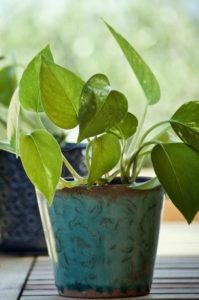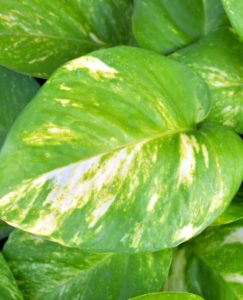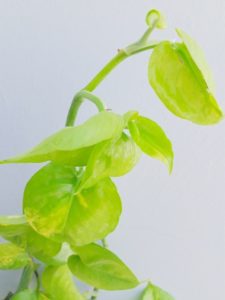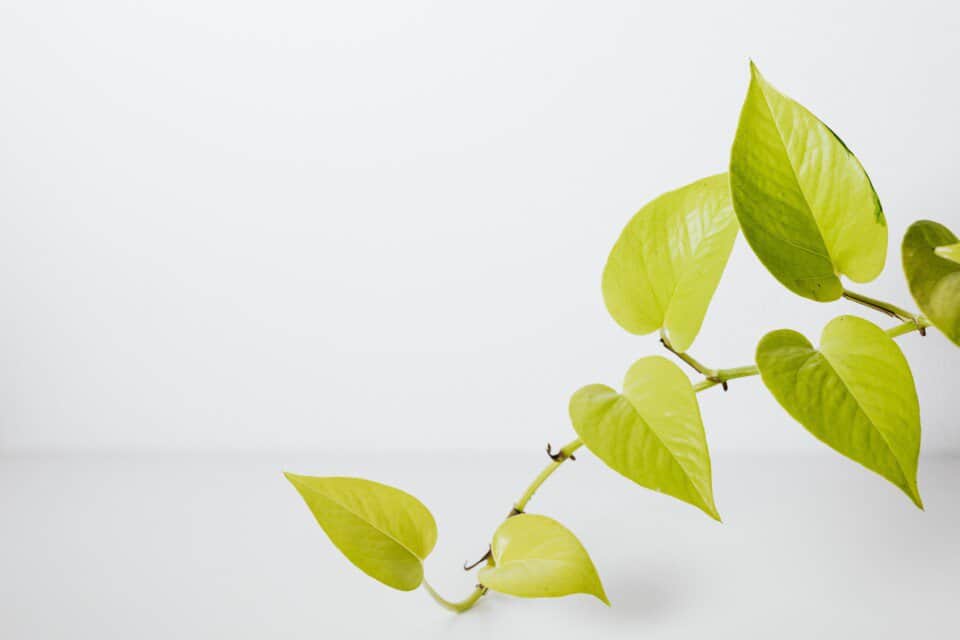Some links in the post are affiliate links and I get a commission from purchases made through some links found in the post.
The pothos plant is one of the most widely owned house plants that come from the tropical environment. Some of the most fascinating indoor plants are tropical ones.
The pothos deserves special attention because it comes in a wide range of variations. This beauty is considered to be one of the most low-maintenance plants, however, it still requires specific care.
Anyone who owns a pothos plant is familiar with how annoying it can be when the leaves start to deteriorate and turn brown.
One of the reasons why pothos leaves are turning brown is poor watering. Both overwatering and soil underwatering might contribute to this issue.
However, other than that range of environmental causes, such as insect infestation, fungus infections, inappropriate fertilizer treatment, excessive or insufficient light, and other environmental variables, can cause the leaves of pothos to become brown.
In this article, we will discuss in more depth pothos leaves turn brown and potential causes and cures will be explored.
Additionally, you will get to also learn some pothos care tips which will help you to maintain your plant to happily thrive.
Why are my Pothos Leaves Turning Brown
1) Overwatering
 The pothos plant is native to tropical regions, therefore it flourishes in hot, dry climates. This indicates that the main reason for pothos leaves turning brown often is overwatering.
The pothos plant is native to tropical regions, therefore it flourishes in hot, dry climates. This indicates that the main reason for pothos leaves turning brown often is overwatering.
The watering schedule is dependent on many different factors including the plant size, position in the home, and surroundings.
If the pothos is planted in a smaller pot, then you will have to give it less water, because it will most likely be evaporated faster. However, pothos located in the larger pot will require more water.
Water indoor plants until the soil are wet as a general rule. When water drains through the drainage hole in the bottom of your plant, it has received enough moisture.
Test the soil by sticking your finger into it approximately one inch deep. If the soil is moist or if wet dirt adheres to your fingertips, then The Pothos requires a little more time to dry before being watered once more.
A potted plant’s roots lose access to oxygen when there is more water in the soil than what the plant itself requires, which results in root rot.
The transfer of vital nutrients to the plant is restricted as the roots eventually die, which causes pothos leaves to turn brown.
It frequently happens to the white and cream-colored areas on highly variegated Pothos cultivars like Manjula and Marble Queen Pothos.
To check your Pothos’ moisture levels, you may use a moisture meter. Pothos leaves turning brown will be reduced if you let it dry out a little bit in between waterings.
If you change your watering schedule but still notice yellowing leaves, there may be another cause. Here are several more causes of browning on your Pothos leaves.
The first step in fixing the problem is to let the potting soil dry up. Then begin watering gradually. However, in this case, make sure to not overwater the plant.
After watering, the soil and roots should be moist, but before the next watering, the soil should be 1-2 inches dry on the top.
Additionally, you must carefully check the soil. Pothos likes soil that is well-draining. Therefore If your soil is excessively dense and stagnant.
If you want to do so, you can make your own potting soil, Or you may get ready-made potting soil for aroids, which should make things much simpler.
Additionally, check for drainage holes in the container before transplanting. Some pots do not come with drainage holes and in that case, you will have to drill them.
The drainage holes let excess water go out, and therefore decreases the chance of overwatering.
2) Irregular Watering Schedule
Even though it is vital to let the soil dry out between waterings, consistency is still crucial. Keep track of the timetable your Pothos plant appears to be on and attempt to water it consistently.
Because pothos plants are hardy, they don’t require a lot of special care. But scheduling irrigation will lessen the possibility of pothos leaves turning brown.
Your Pothos plant will be content if you water it according to a timetable and in the proper amount. This entails watering your Pothos plant until the drainage holes in the pot’s base are filled with water.
The precise time frame will vary depending on the particular plant, but weekly watering is sufficient.
For the first few weeks, keep a check on your soil, and if it’s still damp after a week, give it a few more days. When a plant is ready, it will let you know, and from there you may establish a watering schedule.
Pothos gardeners who have recently relocated their plants indoors from the outdoors have to also adjust the watering schedule.
The plant’s water demands alter when it is brought indoors since it no longer needs as much water to thrive as it would outside.
3) Water type that needs to be used
The water quality is not really a thing that greatly affects pothos plants. Considering that it is a tough indoor plant, typically, pothos is not picky regarding what type of water you use. however, there is one exception in that case.
Typically, your pothos plant will do fine if you give tap water once or twice, however, it is not recommended to use the tap water on your beloved plant frequently.
If your pothos leaves turning brown, and you checked all other possible causes and none of them seem to be a problem, you may have to check what type of water are you giving to your greenery.
In general, tap water carries extra salt, minerals, and fluoride that can harm plants. Although it is doubtful that this is the reason for your browning Pothos leaves, it is important to consider it as a possibility.
It is recommended to give your plants either distilled water or rainwater. However, if those are unavailable, then you can use tap water, but not the one that you just filled up.
Put your tap water in a container or bottle, and set it out for a 24 hours period. This time is enough for the evaporation of harmful chemicals and chloride. After a day, you can give this water to your plant.
4) Too much light
 Pothos plants thrive in indirect, low to medium light conditions. If they receive too much sunshine, the leaves will burn and become brown. This is known as sunburn.
Pothos plants thrive in indirect, low to medium light conditions. If they receive too much sunshine, the leaves will burn and become brown. This is known as sunburn.
The leaf will usually develop huge light brown spots in the middle or on one of the sides. Excessive light can also cause browning of the leaf’s tips or margins. If the leaf is exposed to a lot of sunlight, it may die totally.
Pothos leaves can scorch and become brown if they are overexposed to direct sunlight. Brown sunburn markings develop on the white/yellow/cream patches of highly variegated types such as Golden Pothos and Manjula.
The first step in determining whether this is an issue for your Pothos plant is to monitor the light in the room it is in. The apparent option is to relocate the pothos to the spot where the sunlight is not direct and “burning”. .
The optimal location would be on the south-facing side of a window. This plant can also be placed near an east or west window.
However, you must experiment to determine if it is preferable for the pothos to be in front of or to the side of the pothos.
5) Too Little Light
Although pothos dislikes direct sunlight, it needs sufficient light energy to flourish. Pothos grows slowly in the absence of light, and its stems become elongated and brittle. Pothos leaf yellowing can also be caused by insufficient light.
Not only the direct sun rays are harmful, but also the insufficient like can be as bad. The first symptom that your plant is not getting enough light is when the leaves turn green.
This occurs because the plant is adjusting for the light it would have received. If the plant is kept in this environment for a long period of time, the leaves will turn brown and die.
For example, if your Pothos is growing by the windows, you may use a sheer curtain to restrict how much direct sunlight it receives.
Alternatively, you may relocate it to another location in the room that receives indirect natural sunlight but not as intensely as a window area.
If your Pothos plant becomes greener and the leaves begin to discolor, It is time to relocate your plant. A brighter setting (indirect rays are better) could help your plant recover quickly.
Even though pothos can survive low light levels, the best way to treat brown leaf tips is to supply your houseplant with moderate indirect light.
If you don’t have such a location in your home, It is recommended to get artificial light to make sure your plant gets the proper amount.
6) Temperature
Pothos plants are ideal for beginning gardeners. They can survive a wide range of living situations and temperature is no exception from this.
While this is correct, the optimal temperature range of pothos is 70°F to 90°F. If your Pothos is exposed to extreme temperatures for an extended length of time, it may experience temperature shock.
This can happen either way, although it happens more frequently when the temperature drops.
The Pothos plant’s comfort threshold is so high that it is less prone to suffer from heat stress. When temperatures fall below 70°F on a frequent basis, your Pothos plant’s leaves may brown.
Increase the heat if you suspect your Pothos plants have brown blotches from repeated cold exposure. Placing a space heater in the room with your plant (but not too close to it) will also do fine.
Checking the weather to prepare for days that aren’t between 70°F and 90°F. If the weather is likely to be chilly, relocate your plant to a warmer area. If the weather is likely to be hot, try to keep the plant as cold as possible.
If you have the plant placed outside in the garden or on the balcony, bring it in to avoid additional complications regarding the temperature changes. The pothos likes to be cultivated in a temperature-controlled environment.
7) Fertilization issues
 Browning leaves might be caused by insufficient fertilization. This usually suggests you’re applying too much fertilizer. Fertilizer burn can turn your pothos black.
Browning leaves might be caused by insufficient fertilization. This usually suggests you’re applying too much fertilizer. Fertilizer burn can turn your pothos black.
The leaf margins and tips become brown first, followed by the main sections. Other signs include lower leaves turning yellow and overall plant weakening.
Too much fertilizer will result in burning the roots which are also referred to as scorching. overfertilization shocks the plant since it receives too many nitrogen salts and will gradually destroy your plant.
The first indicator of over-fertilization is pothos leaves turning brown.
Pothos plants require fertilizer once a month. The amount is determined by the size of your plant and fertilizer type. Buying a good fertilizer and following the instructions should keep the plant safe.
If you think that the overfertilization has happened because of the buildup of salts in the soil, you can try out the flushing method.
By this method, the salts come out by running water through the dirt. Water the plant thoroughly and too much water will cause the extra salts to be washed out from the holes.
The water has to be twice the volume of the pot. you can repeat this process twice to make sure that all extra fertilizer is gone.
You may also do the opposite and refill the dirt in the container. Remove the pothos from the container and gently remove any old dirt from the roots.
Try not to injure any roots and avoid washing them. Plant the pothos in fresh, loose, and well-draining soil.
The next thing to do is to avoid overfeeding the pothos. During the growth season, this plant need only be fed once every 4-8 weeks.
Also, make sure not to use an excessive amount of fertilizer. NPK fertilizer 10-10-10 is the finest. Do not fertilize the pothos plant in the late autumn and winter, because this is a dormant period for the plant.
8) Pest Infestation
The most prevalent invaders on Pothos plants are scale insects and mealybugs. Scale insects resemble little yellow blobs with a black patch in the center.
Mealybugs are fizzy and white in color. Both damage the plant’s immune system by sucking its fluids, which can cause browning leaves.
Infestations may be avoided by keeping your plants clean. To maintain your Pothos pest-free, dust the leaves with a towel once a week.
There are ways to get rid of pests on your Pothos if you think that the plant has an infestation or have spotted them. The tools which you will need to cure the infestation are insecticidal soap, neem oil, and rubbing alcohol.
The neem oil and soap will have the effect of suffocating the bugs upon contact. Spray it on your leaves and you’re done. To eliminate the infestation, carefully wipe the foliage one by one with an alcohol-soaked cotton ball or cloth.
9) Bacterial Diseases
Bacterial wilt illness can harm the health of your Pothos plant. This is more typical in commercial plant production. This might be the cause of browning leaves you observe soon after bringing your plant home.
The first sign of bacterial diseases is pothos leaves turning brown and black veins running down the stem. If you suspect your plant has bacterial wilt disease, you can check it by doing a simple trick.
Remove one stem and immerse it in water. Bacteria will swim into the water if it is contaminated. There is also oozing at the base of the stem where you cut it. If the condition is detected early enough, the cure of it will be easier.
You can cure bacterial diseases by using the bactericide. additionally, to further avoid the bacterial disease problem, maintain adequate air circulation and moderate humidity, and treat the plant frequently with copper hydroxide-containing fungicides.
10) Fungal Diseases
Fungal disease can lead to a variety of problems for your Pothos, including pothos leaves turning brown. If you think that your plant has a fungal disease, you must act fast to prevent the infection from spreading.
Southern blight is a serious fungal illness that affects Pothos plants. Aside from dark leaves, there are typically white strands of fungus creeping from the dirt up the stem.
If the temperature is high and the soil is often damp, this illness will spread quickly.
You must remove the contaminated sections of the plant and report the healthy plant. Remove all unhealthy tissue and clean all wounds with fungicide.
The plant should next be planted in clean, loose potting soil. Make sure to disinfect the pot well if you think of using it again because fungus can live on the pot and infect the plant again. Keep an eye out for re-infection on your plant.
11) Root Rot
 Root Rot is a widespread disease that affects many plants and the pothos is among those. The root rot is frequently caused by excessively deep soil, overwatering, or a lack of drainage in the container.
Root Rot is a widespread disease that affects many plants and the pothos is among those. The root rot is frequently caused by excessively deep soil, overwatering, or a lack of drainage in the container.
Mold will grow in a damp environment if the soil is not allowed to drain properly and does not dry all the way. If your Pothos is infested with root rot, the leaves will become yellow, and if it continues so, will result in the pothos leaves turning brown.
Many people recommend putting out a plant with root rot (in the container), however, there are various techniques to save your plant first. What you can do when you spot the plant having root rot is the following:
- Remove pothos plant from the pot carefully.
- Remove the old dirt and the brown/mushy roots.
- Remove the rotten roots and disinfect the ones that are still healthy. typically, healthy roots are firm and white.
- Replant your Pothos in the clean soil and container when it has dried, and keep an eye on your watering to ensure it doesn’t happen again. This is critical for avoiding future Root Rot problems.
A fresh pot and clean soil can drastically reduce your chances of reinfection. Also, if you keep the watering schedule according to the plant requirements, the root rot will most likely be avoided.
12) Soil Problems
Pothos plants require well-draining soil. This is essential to let the soil dry between waterings. It is far more difficult to avoid overwatering if the soil is too compact.
Not all potting soil is created equal. If you use high-quality soil, your plant will thrive. That implies plenty of aeration and drainage for Pothos plants.
If you suspect that pothos leaves turning brown are caused by dirt, you can gently repot your Pothos. If you do this, make sure your pot has adequate drainage at the bottom.
The use of pebbles or small rocks can make it simpler for water to flow through to the drainage hole and prevent erosion.
13) Natural aging of the plant
Plants, sadly, do not live forever. If you are still experiencing pothos leaves turning brown after resolving the issues listed above, it might be due to natural factors.
A Pothos plant has an average lifespan of 5 to 10 years in the absence of illness or infestation.
Should I cut brown leaves off pothos?
Depending on how bad the issue is, you might need to remove the brown leaves turning brown from your Pothos plant. If more than half of the leaves are seriously impacted,
The ideal solution would be to cut the poorly afflicted leaves to enhance the chances of survival for the leaves that are still healthy.
Your plant’s general health will improve if you remove the brown leaves so that nutrients may flow to the healthier sections of the Pothos.
However, it won’t be required to remove those leaves if the issue isn’t severe and just a few leaves are impacted. Instead, you could want to identify and address the underlying reasons in accordance with the previously covered parts.
Final Thoughts
 Pothos leaves turning brown can be caused by leaf spot disease, overwatering, underwatering, or too much light. Brown patches and brown leaf tips can also result from using too much fertilizer on pothos plants.
Pothos leaves turning brown can be caused by leaf spot disease, overwatering, underwatering, or too much light. Brown patches and brown leaf tips can also result from using too much fertilizer on pothos plants.
If you make sure to follow all the caring tips carefully, most likely, nothing bad will happen to your green friend.
Remember, Before watering, allow the top 25% of the soil to dry out to prevent brown patches and tips, give your pothos plant strong indirect light and apply fertilizers carefully.


